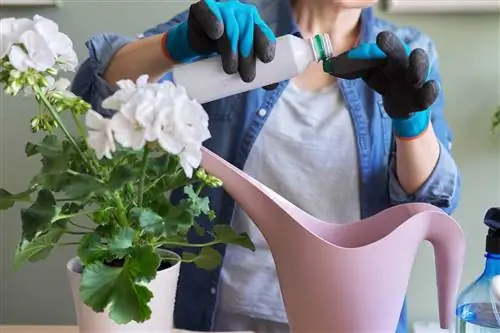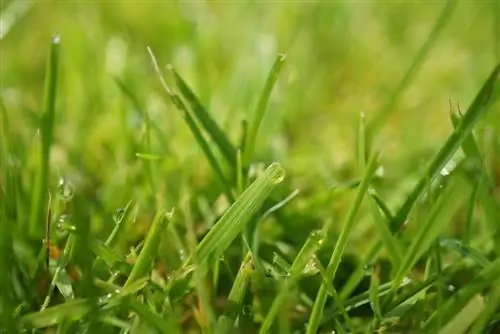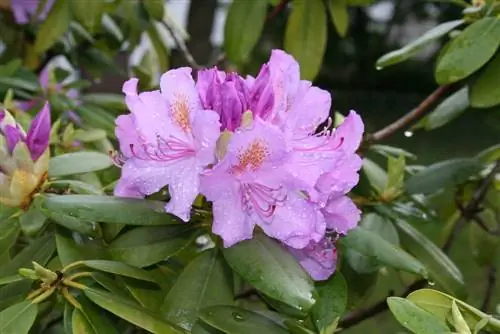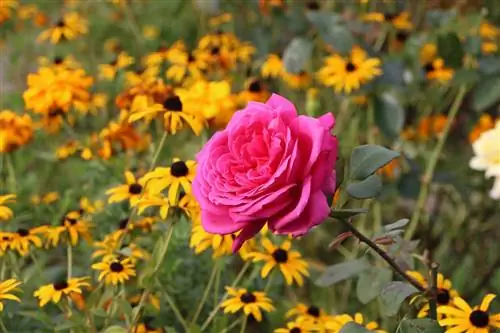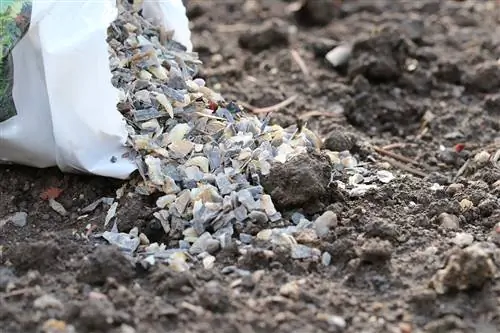- Author admin [email protected].
- Public 2023-12-17 03:39.
- Last modified 2025-06-01 06:48.
Green plants in pots or containers only have a very limited amount of soil and therefore nutrients available. These are gradually used up by the plant and then have to be replaced. While very slow-growing houseplants only need to be fertilized very rarely or not at all, quickly and vigorously growing green plants require higher amounts of fertilizer. Plants that are rarely repotted and receive fresh substrate in particular need to be fertilized regularly.
Basic rules for fertilization
The question of whether green plants need to be fertilized at any time of the year can be answered with a clear “no”. However, which season is right for different plants depends on the type of green plant. Most plants need additional nutrients between February and August as they grow during this time and take a break during the winter. As always, there are exceptions to this rule, namely houseplants that go into their dormant phase in the Central European summer. For plants that bloom in winter, fertilization is usually not stopped completely, but only reduced.
What nutrients do green plants need?
Different nutrients are important for growth, metabolism and flower and fruit formation. There are six main nutrients in total. The three most important ones are:
- Nitrogen (N) - as nitrate
- Phosphorus (P) - as phosphate
- Potassium (K) - as s alt in soluble form
Fertilizers that contain these three components in different proportions are therefore also called complete fertilizers. Nitrogen is responsible for the construction of plant proteins and photosynthesis. Phosphates are involved in metabolism throughout the plant. Plants need potassium for water absorption and tissue formation. There are also three other nutrients, namely:
- Calcium (Ca)
- Magnesium (Mg)
- Sulfur (S)
Calcium is an important component of the cell walls in plants, while magnesium is involved in both photosynthesis and metabolic processes. Small amounts of sulfur are also necessary to form amino acids and proteins.
Important trace elements
In addition to the six main nutrients, plants also need small amounts of other minerals (trace elements). These are necessary in different quantities for almost every plant. These include, for example:
- Zinc
- Copper
- Manganese
- Iron
Solid and liquid fertilizers
A wide variety of fertilizers for specific plant families are available commercially. The fertilizer is usually specifically tailored to the special needs of these plants and the ratio of nitrogen, phosphorus, potassium and other nutrients is optimized. There is fertilizer as:
- Granules
- Liquid fertilizer
- Fertilizer sticks
- Tablets
- Powder
Liquid fertilizer and various solid fertilizers are mixed with or dissolved in the irrigation water. These fertilizers contain almost exclusively mineral nutrients that dissolve well in water. Since the s alts are absorbed directly by the plant, the fertilizers have no long-term effect. As a rule, the fertilization process must therefore be repeated at regular intervals (approximately every two weeks).
Solid green plant fertilizers such as fertilizer sticks are inserted into the soil of the potted plant or incorporated into it and poured on. They usually consist of a mixture of organic and mineral nutrients. These fertilizers release a small amount of nutrients immediately and the rest over a few weeks or months. This form of fertilizer is one of the long-term fertilizers. Sometimes a single application of fertilizer at the beginning of the growing season is enough for the entire year. Additional fertilizer applications are not necessary here.
Tip:
If there are small children in your household, stick the fertilizer sticks deep into the soil so that they are not accidentally removed and swallowed.
Prevent deficiency symptoms
Not only the amount of fertilizer is crucial for green plants in pots, but also the composition of the individual nutrients in the fertilizer. So when does it have to be fertilized with what?
- more nitrogen: pure leafy plants (green plants) during the main growing season
- more phosphorus: before and during flowering, during fruit formation
- more potassium: during fruit formation, in bulbous and tuber plants after flowering
Which fertilizer is the right one?
It depends on the plant. Some plants have special requirements when it comes to fertilizer composition. There is no need to buy dozens of different fertilizers for houseplants. Basically four different ones are sufficient:
- Cactus fertilizer
- Orchid fertilizer
- Flowering plant fertilizer
- Green plant fertilizer
Special green plant fertilizers
Various manufacturers offer special green plant fertilizers for palm trees, for example, but in principle these contain the same nutrient concentrations as normal universal or green plant fertilizers. Hobby gardeners can therefore do nothing wrong if they fertilize their green plants with a universal fertilizer for leafy plants. In contrast to flowering plants, green plants require slightly less phosphorus. What is essentially interesting is the ratio of nitrogen to phosphorus. The potassium content should roughly correspond to the nitrogen content. Typical green plant fertilizers:
- NPK: 7-3-6
- NPK: 14-8-20
- NPK: 7-4-10
- NPK: 15-5-20
If there is further information (with or without brackets) after the three numbers (for example 15-5-20-2), the fourth number refers to the magnesium content. The absolute numbers say something about how concentrated the fertilizer is. Smaller amounts of this then have to be used for fertilization. This is often reflected in the price. Magnesium is important for conifers to form leaf green.
Tip:
The Hawaiian palm is an exception. It should be fertilized monthly in winter with cactus fertilizer in half the specified concentration.
The importance of lime and calcium
In addition to nitrogen, phosphorus and potassium, plants also need calcium. This nutrient is not only necessary for strong cell walls in plants, but also plays a major role in soil pH. The calcium compounds such as lime ensure an increase in the pH value in the soil. So why is there no calcium in green plant fertilizer? It's simple: Almost all gardeners water their potted plants with normal drinking water. In contrast to rainwater, this contains lime. Lime is added to the soil with every watering. Unfortunately, this permanently increases the pH value in the soil. However, most plants prefer slightly acidic pH values (4-5). That is why the pH value in most green plant fertilizers (for houseplants) is lowered to this value.
Natural fertilizer - home remedies
Although there are a lot of natural green plant fertilizers or home remedies, since these often smell bad (like nettle manure) or mold very easily (like coffee grounds), they are only suitable for use in the home to a limited extent. Eggshells are also usually rather unfavorable because the soil already has too much lime from the tap water for watering. However, if you use coffee pods, you can soak them in water for a few hours. Black tea bags or herbal teas also release a little acid and nutrients after they have been used for brewing.
Conclusion of the editors
With a few exceptions, green plants in the apartment are fertilized at regular intervals (approximately every two weeks) between the end of February and the beginning of August. During the rest of the time, the plants go through a resting phase in which no additional nutrients are necessary. Plants without flowers or fruits are well served with a universal fertilizer for green plants. Important here: lots of nitrogen, less phosphorus, about as much potassium as nitrogen. You can't go wrong with this.
What you should know about green plant fertilizer in brief
Green plants need just as many nutrients and trace elements as all other plants. You can also give them this with the appropriate green plant fertilizer when watering them every day. And this fertilizer application is important because it ensures lush, juicy leafy greens. And this is exactly what is most important to the owners of green plants. Because without lush and juicy green, the green plants only look half as beautiful.
- The green plant fertilizer is best mixed with daily irrigation water and applied about once a week.
- However, it is only used so frequently during the growth phase. During rest periods, it is sufficient to fertilize once a month.
- There are hardly any special features to consider when choosing the right fertilizer.
- The only important thing is that the green plant fertilizer was designed exclusively for green plants and not for flowering plants.
- It should always be composed in such a way that it covers the ideal needs of the green plants common in this country.
- If you don't fertilize green plants or don't fertilize them enough, you have to expect that they will quickly lose their lush color.
- The prices per liter are between 6 and 8 euros. But here too, a comparison of several providers is advisable.
- The composition of most green plant fertilizers is almost identical anyway. Therefore you can also buy a cheaper product.

